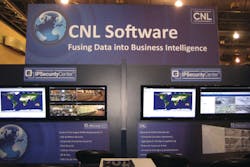Moving beyond integration with PSIM
Several years ago when the security industry became abuzz over the concept of physical security information management or PSIM, there was still a lot of confusion over what benefits the technology offered over traditional video management systems. As end users have become more familiar with what PSIM brings to the table, not just in terms of security management but business operations as a whole, industry experts say the focus of these platforms needs to move from simply what devices they can integrate to how they can leverage them to run their organizations better.
"PSIM has nothing to do with integration," said Dr. Bob Banerjee, senior director of training and development for NICE Systems. According to Banerjee, a good PSIM solution is about three things; situational awareness (knowing that something is happening and tracking it), situation management (the steps that should be taken during an incident) and situation reconstruction (looking back at the steps that were actually taken).
"That is what PSIM is about," Banerjee said. "That’s why we call our solution ‘Situator.’ PSIM is a stupid name."
Larry Lien, vice president of product management for Proximex, agrees that when the market was in its infancy, PSIM was talked about more for what it could integrate rather than how users could act upon that information.
"The future is what you do once you have that information," said Lien. "For example, if there is a smoke alarm, is there smoke? If there is, they do these five things, if not, they do these five things."
After initially using a roadshow concept to educate prospective customers on the benefits of PSIM technology, Banerjee said that NICE realized that it wasn’t really working and they have now replaced their roadshows with workshops, which involve going into a user’s facility and working through actual scenarios where a PSIM platform could benefit them.
More and more, Banerjee said that organizations are starting to realize that PSIM technology can be used for more than just security and are making it a part of business operations. In fact, according to Banerjee, this trend is an absolutely necessity for vendors if they want to be able to sell their respective platforms to customers going forward.
"There is not enough money to pay for these systems. If you only run to the security wallet, you have a problem," he added.
Because situation management depends on having standard operating procedures in place for a wide variety of scenarios, one of the challenges for an end user is creating the policies and guidelines that need to be followed for specific events. Having experience installing PSIM solutions across a wide range of applications, Nice Systems is addressing this issue by creating template procedures that are already pre-loaded for users, which can be a tremendous time saver.
"When you buy Situator or any other PSIM, it’s like Microsoft Word," Banerjee explained. "You have to create your policies from scratch."
Kelly Fiedler, vice president of marketing for VidSys, said that one of the challenges has been getting end users to match up the standard operating procedures used in their PSIM systems with the potential risks that they’ve identified in their respective industries, which vary significantly from organization-to-organization and from market-to-market. Fiedler added that while budgets are not as tight as they were several years ago, end users are still concerned about proving the ROI of a PSIM platform. However, she said that more city leaders and C-Suite executives are beginning to realize the benefits.
"This is a strategic decision for the organization," she said.
Aside from the typical markets that have been the main proprietors of the technology such as critical infrastructure sites (airports and seaports), Fiedler said that she’s started to see more interest from organizations in the healthcare sector for PSIM due to its ability to aid in the tracking of medical equipment, as well as high-tech and financial services companies that have numerous locations to manage. Demand for PSIM is also growing geographically, according to Fiedler, who said that there is growing interest from organizations in Europe, China and the Middle East.
Another market trend that Lien said was important to note was the move towards industry standards and the ability of PSIM solutions to be compliant with them. Lien said that Proximex, which offers the Surveillint platform, can support three PSIA specifications.
According to Matthew Kushner, president of CNL Americas, which offers the IPSecurityCenter PSIM platform, there has been a validation process of the technology that has taken place over the last two to three years as companies and governments have waited to see how the software performed in actual deployments.
"When you’re introducing enterprise technology, you want to see it working," said Kushner. "It sits over the entire security estate, so you don’t make that decision (to deploy a new technology) lightheartedly."
Now that the technology has been vetted, however, Kushner said people realize that it delivers by solving real business problems. "The overall health of this (product) category is clear, PSIM is here to stay," he added.
In the UK, for example, which has one of the most robust public surveillance networks in the world, Kushner said officials there have seen the benefits of leveraging PSIM technology for being able to more easily comb through video footage. Whereas it took thousands of man hours to pour over footage from the London subway bombings in 2005, Kushner said that time could reduced to mere minutes with PSIM.
Because of benefits such as these and that fact that PSIM has been successfully deployed in many applications, more widespread adoption of the technology will likely increase as well, according to Kushner, who believes that the market is moving out of the validation phase and into the mining of business intelligence. "I think over the next two to three years, you will see the adoption rate will continue to increase," he said.
Industry leaders agree that one thing that could potentially hinder the market’s growth is the piggybacking of VMS companies, who while they don’t offer a true PSIM solution, still want to ride the wave by offering what many people like to refer to as "PSIM-light" solutions. Lien said that the business logic layer of a true PSIM solution really differentiates it from an enhanced video management system that’s masquerading as PSIM.
"We’re having a lot of guys come and say ‘' can aggregate two pieces of video.' That’s not a PSIM," Kushner said.
About the Author
Joel Griffin
Editor-in-Chief, SecurityInfoWatch.com
Joel Griffin is the Editor-in-Chief of SecurityInfoWatch.com, a business-to-business news website published by Endeavor Business Media that covers all aspects of the physical security industry. Joel has covered the security industry since May 2008 when he first joined the site as assistant editor. Prior to SecurityInfoWatch, Joel worked as a staff reporter for two years at the Newton Citizen, a daily newspaper located in the suburban Atlanta city of Covington, Ga.

